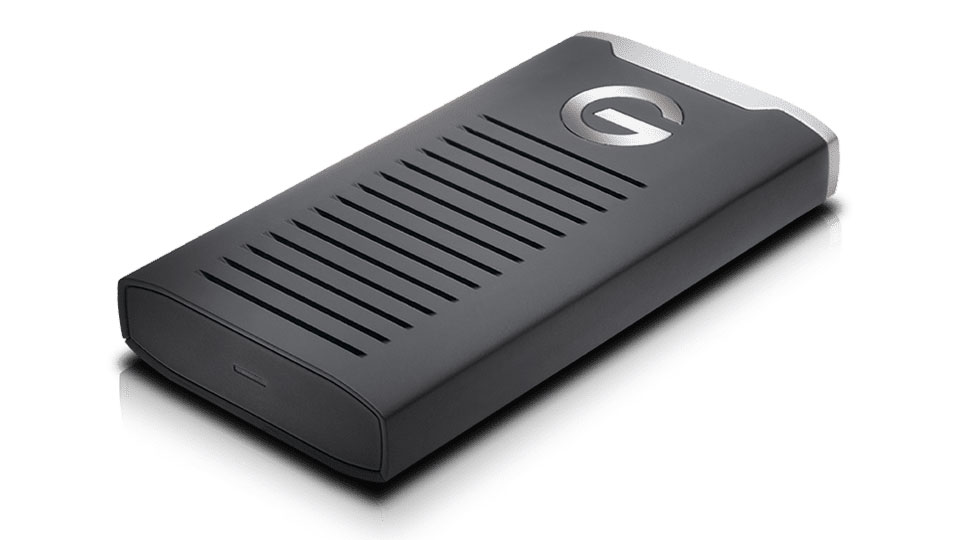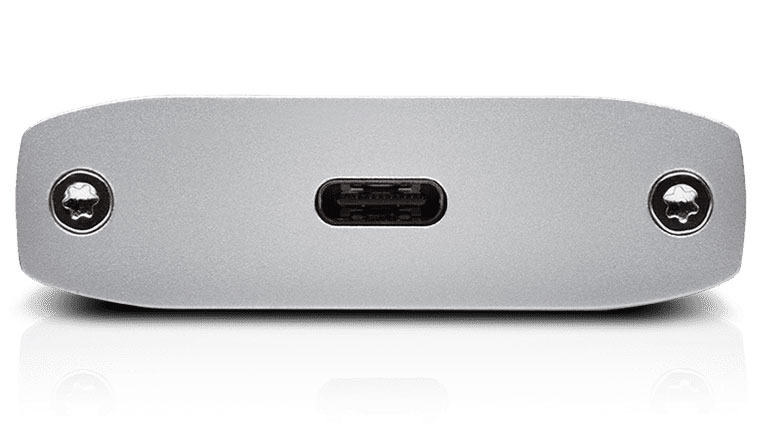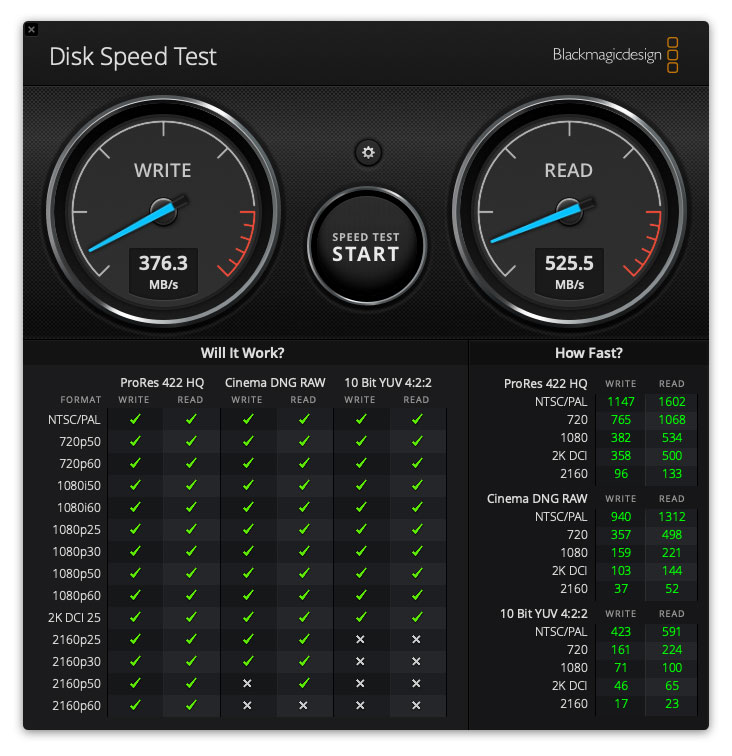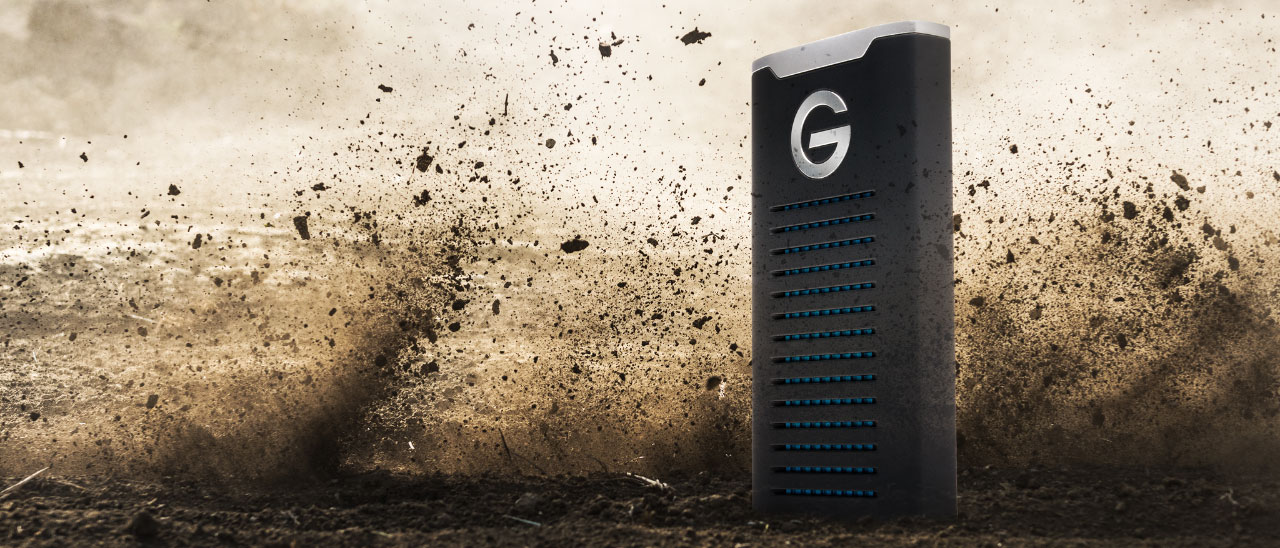Digital Camera World Verdict
Portable SSD drives are expensive, but we’re reaching a point, especially for video, where regular portable hard drives are just too slow. The G-Drive Mobile SSD R-series for USB 3.1 Gen 2 offers the fast data transfer speeds we’d expect from solid state storage, but also a water and dust resistant case that can stand a 3m drop and a 1,000lb crushing force.
Pros
- +
Up to 560MB/s data transfer
- +
IP67 water and dust resistance
- +
3m drop, 1,000lb crush protection
Cons
- -
SSD cost per TB
- -
Short USB cable
- -
Thunderbolt MUCH pricier
Why you can trust Digital Camera World
You can never get enough storage, especially if you use a computer with limited internal expansion capability. Besides, a plug-in external drive isn’t just simpler, it helps you take your work with you, back it up and access it from different machines, and that's a lot more convenient than getting a regular desktop drive. The G-Speed Shuttle 4Bay Thunderbolt 3 we've just reviewed is portable in its own way too, but only if your car is parked right outside...
The challenge, though, is getting a genuinely portable pocket-sized drive that’s fast enough. It’s bad enough for photographers storing and transferring large batches of image files, but worse for videographers, who may need to play back and edit video in real time, so to get the best portable hard drive you may actually have to ditch HD technology altogether and swap to SSD.
• The best portable SSDs in 2020
Regular portable hard drives are fine for capacity, but – to be honest – slow as heck. They’re OK for archiving, transport, single image editing or for batch processing that you can leave running while you do something else, but that’s about it. If you want REAL speed, you need an SSD drive, and this is where it starts to get expensive.
The G-Drive Mobile SSD R-series 500GB we’re reviewing here has a pretty modest capacity but still costs more than a regular 4TB portable hard drive with eight times the capacity. It’s available in bigger capacities than this, but the cost escalates in proportion, so the 2TB version of this drive costs around £519/$559.
There’s something else to be aware of. This drive uses USB 3.1 Gen 2 and has a maximum data transfer rate of 560MB/s. If you’re really serious about speed and you’re working with high-quality 4K video or even 8K, you’ll need the G-Drive mobile Pro SSD versions which look quite similar but come with Thunderbolt 3, have a maximum quoted 2,800MB/s transfer speed and cost roughly twice as much.
Don’t buy the wrong one by mistake.

Build and handling
There are quite a few portable SSD drives on the market now, but the G-Drive Mobile SSD R-series looks quite different and has one very important feature – it’s been ‘ruggedised’ like other portable G-Drives we’ve seen, but without the lurid rubber bumpers around the edges. It’s half the size of its hard disk equivalents and its styling is more subdued and sophisticated.
Nevertheless, it’s both water and dust resistant, it can withstand a drop from a height of 3m, and it can withstand a crushing force of 1000lb. If you like to sling your camera bag down rocky gullies and hike through driving rain, you might be glad of that.
The rugged design could prove a godsend one day and doesn’t appear to add much of a price premium. Even better, this drive is tough without looking like it belongs in a toddler’s toy box.
The case has a nice soft matt finish, a smart reflective blue slatted pattern and a USB C cable that slots in with a good, firm click at both ends (there’s also a cable for older USB 3/USB 2 sockets). The cable is very short, though. That’s great if you’re connecting it to a laptop, but not so good if you’re left fumbling about at the back of a desktop machine amongst all the cables, dust and other geological detritus that finds its home behind a computer.

Performance
We tested the G-Drive Mobile SSD R-series 500GB drive using the Black Magic Speed Test Utility and achieved read/write speeds of 525MB/s and 326MB/s respectively. That’s slightly down on the claimed 580MB/s maximum, but not by much, and according to the test its fast enough for reading/writing 4K 4:2:2 ProRes video at up to 60/50p or Cinema DNG RAW at 30/25p.
For comparison, it’s four times faster than our Seagate 8TB external hard drive (146/136MB/s) and six times faster than our 4TB portable WD Passport hard drive (a puny 86/83MB/s).

Verdict
Mobile SSD storage is expensive, and there’s no getting round it, and the G-Drive mobile 500GB works out at around £286/$300 per terabyte. If you just need inexpensive bulk storage for still image files, then a regular portable hard disk will offer you a lot more storage for a lot less money – provided you don’t mind the slow data transfer speeds.
If you’re editing single images stored on a drive like this you probably won’t notice, but if you need to transfer and work with lots of images, an SSD – expensive as it is – can feel like it’s worth the extra. And if you’re editing video direct from your portable drive, then SSD is definitely the way to go.
The G-Drive Mobile SSD R-series 500GB is a very likeable little device, but we’d pay even more (yes more) to get the 1TB or ideally the 2TB version, as 500GB really isn’t very much by today’s standards (we’re told the data transfer performance is the same across all three capacities).
Read more:
• The best portable drives for photographers
• The best monitors for photographers
• The best USB-C monitors for photo-editing
• The best photo-editing laptops
• The best A4 and A3 photo printers

Rod is an independent photography journalist and editor, and a long-standing Digital Camera World contributor, having previously worked as DCW's Group Reviews editor. Before that he has been technique editor on N-Photo, Head of Testing for the photography division and Camera Channel editor on TechRadar, as well as contributing to many other publications. He has been writing about photography technique, photo editing and digital cameras since they first appeared, and before that began his career writing about film photography. He has used and reviewed practically every interchangeable lens camera launched in the past 20 years, from entry-level DSLRs to medium format cameras, together with lenses, tripods, gimbals, light meters, camera bags and more. Rod has his own camera gear blog at fotovolo.com but also writes about photo-editing applications and techniques at lifeafterphotoshop.com

